|
 |
|
 |
|
|
|
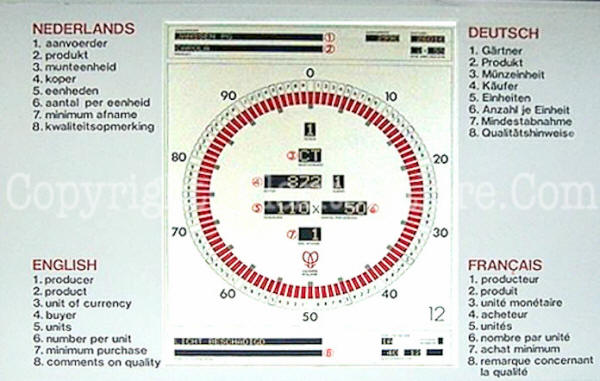 |
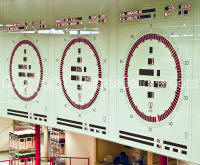 In
1968, two flower auctions joined together to form the Aalsmeer
Flower Auction. The building in which the auction is held has
expanded to over 846,000 square meters. It is a grower's
cooperative with In
1968, two flower auctions joined together to form the Aalsmeer
Flower Auction. The building in which the auction is held has
expanded to over 846,000 square meters. It is a grower's
cooperative with
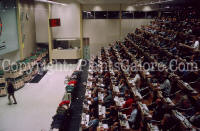 over 3,500 member companies. Most of the
flowers come from the Netherlands but some also come from
Israel, Kenya, Zimbabwe, Zambia and other foreign countries. over 3,500 member companies. Most of the
flowers come from the Netherlands but some also come from
Israel, Kenya, Zimbabwe, Zambia and other foreign countries.
|
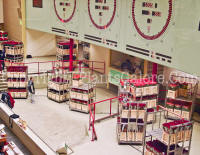 The timing clock at the Aalsmeer
flower auctions. As the time on the clock declines from 100, so
does the price of the item. The first person to bid, gets the
item at that price. If you wait too long hoping for a lower
price, you might get shut out if others are willing to pay a
higher price. The timing clock at the Aalsmeer
flower auctions. As the time on the clock declines from 100, so
does the price of the item. The first person to bid, gets the
item at that price. If you wait too long hoping for a lower
price, you might get shut out if others are willing to pay a
higher price.
|
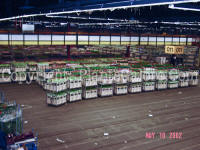 The auction house is huge, about the size of 9 football fields
under one roof. The carts of plant material are hooked together
and pulled through the auction area where it is displayed to the
bidders one cart at a time. The auction house is huge, about the size of 9 football fields
under one roof. The carts of plant material are hooked together
and pulled through the auction area where it is displayed to the
bidders one cart at a time.
|
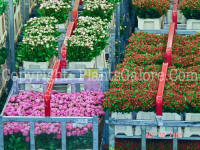 Here, a train of
carts of flowers destined for floral arrangements ready to be
run through the auction area. Here, a train of
carts of flowers destined for floral arrangements ready to be
run through the auction area.
|
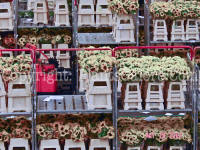 Each cart consists
of a number of containers. In this case, there are 24 containers
of hosta leaves. During the auction, the winning bidder may
choose to take them all or as little as 1 of the containers. Each cart consists
of a number of containers. In this case, there are 24 containers
of hosta leaves. During the auction, the winning bidder may
choose to take them all or as little as 1 of the containers.
If the first bidder does not want the entire cart, the remaining
containers are then put up for bid. The next winning bidder may
take all of the remaining containers or some portion of them.
This continues until all containers on the cart are sold.
|
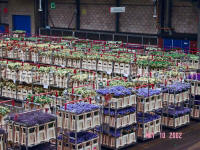 After the contents
of a cart are sold, the individual containers are split off and
placed on other carts according to who purchased them. If, for
example, Smith Florist bought two containers of hosta
leaves, they would be placed on the Smith carts. After the contents
of a cart are sold, the individual containers are split off and
placed on other carts according to who purchased them. If, for
example, Smith Florist bought two containers of hosta
leaves, they would be placed on the Smith carts.
At the end of the auction day, the trains of carts are taken to
the nearby airport where the plant material is loaded onto
planes to their ultimate destination all over the world.
|
Bloemenveiling Aalsmeer
Legmeerdijk 313
1430 BA AALSMEER
Netherlands
|
 |
 |
|
|
|
|

|

Ever wonder where those flowers
came from that are delivered to your loved ones? Many of them
are shipped to Aalsmeer, Holland, auctioned off and loaded on
an airplane for shipment to your florist in the U.S. The
volume of plant material and the efficiency of its handling
are amazing as millions of dollars worth of goods pass through
the auction at each session.
Every unit of plant material is
sold in a classic "Dutch auction." A clock is started and as
the time elapses, the asking price declines. The first buyer
to bid gets the plants or cut flowers at that price.
So, if you wanted to pay $10.00
for a certain group of flowers but everyone else was willing
to bid at $10.50, you might get left out. If you really needed
those flowers to fill an order, you would have to decide
whether to go higher and lose your profits. Or, you could
stick to your price and run the risk that all the flowers
would be sold at a higher price. No wonder the bidders were
well supplied with antacids.
|
|
|
|
|



